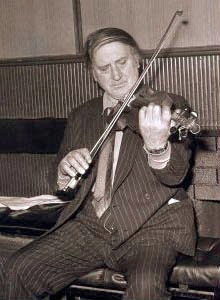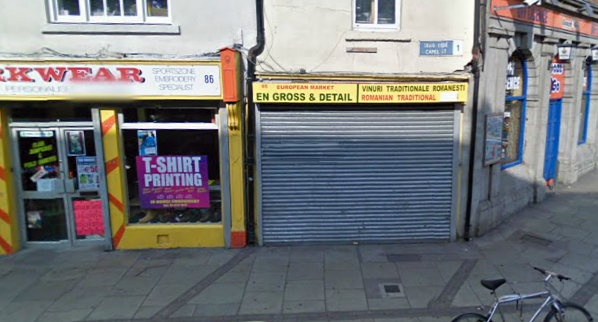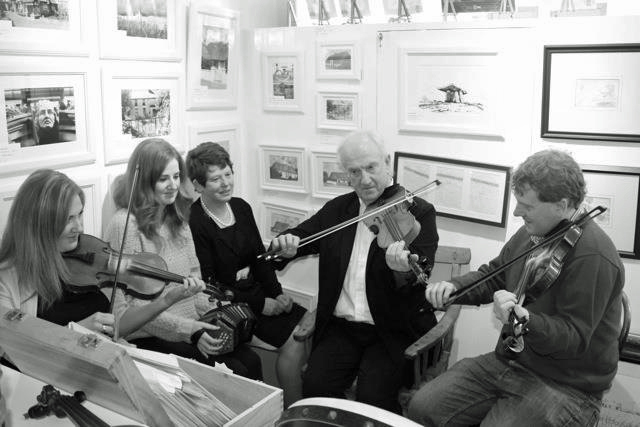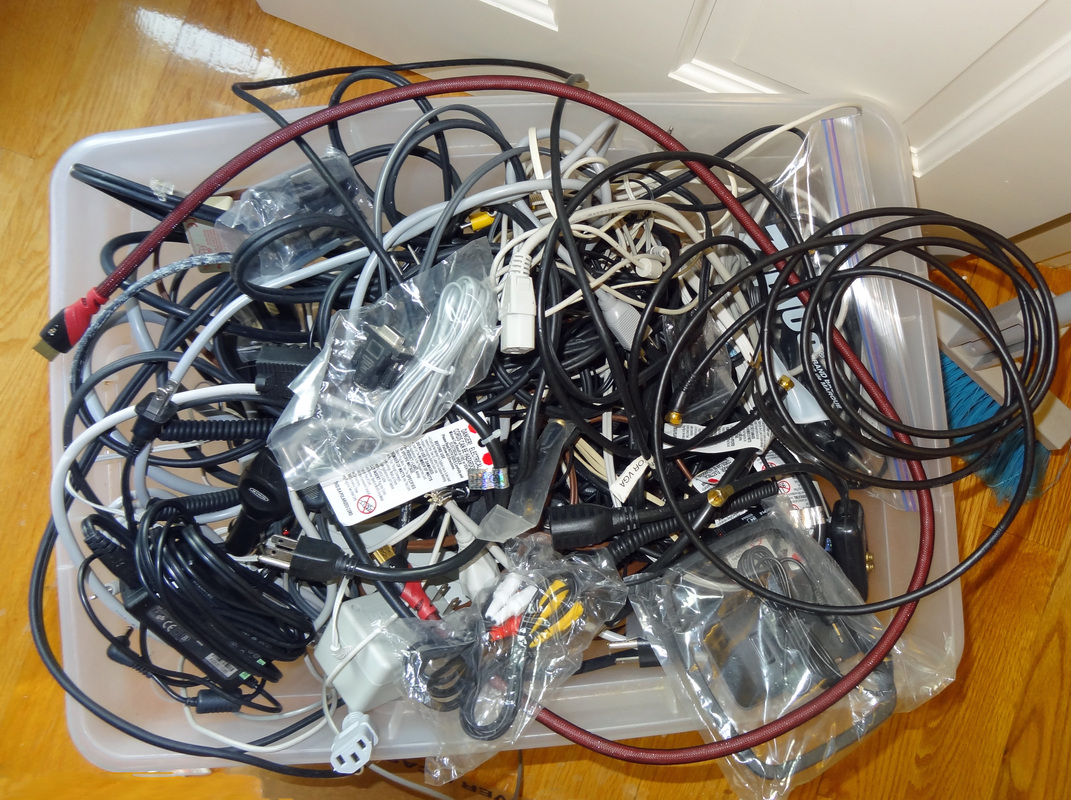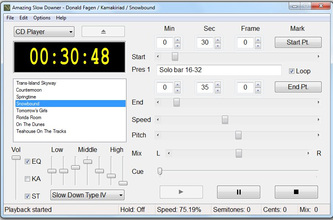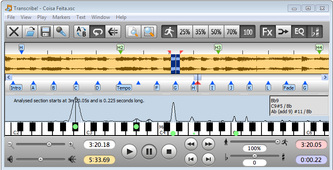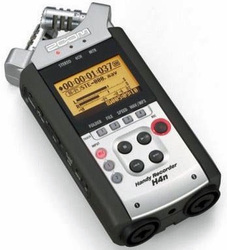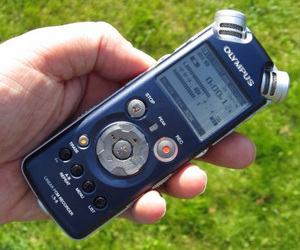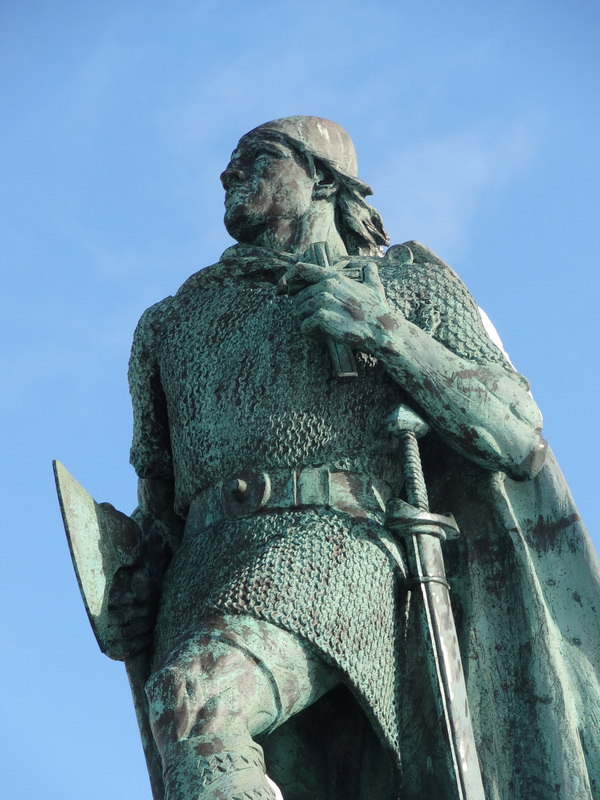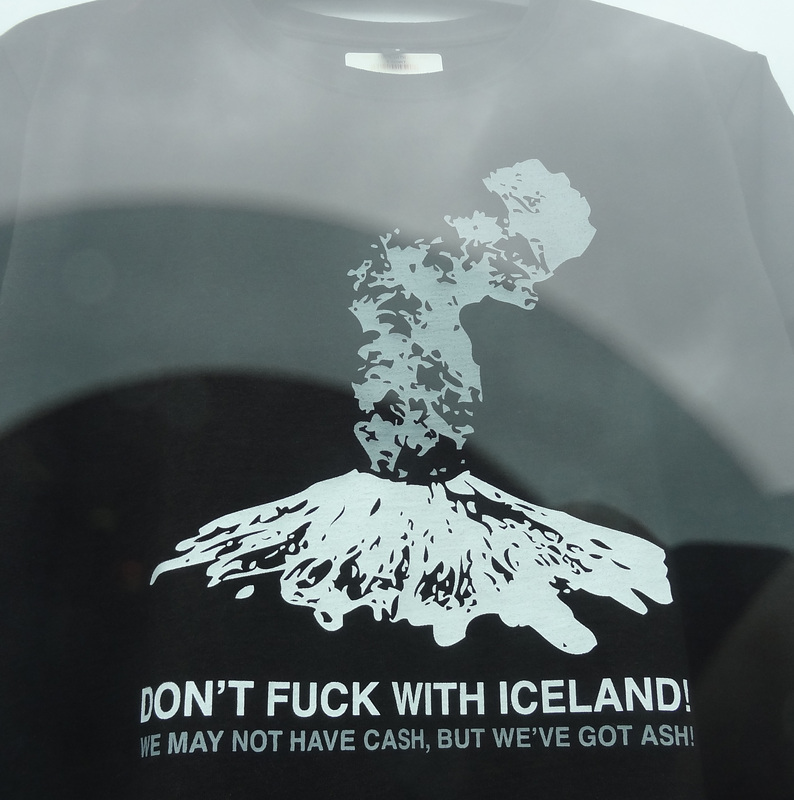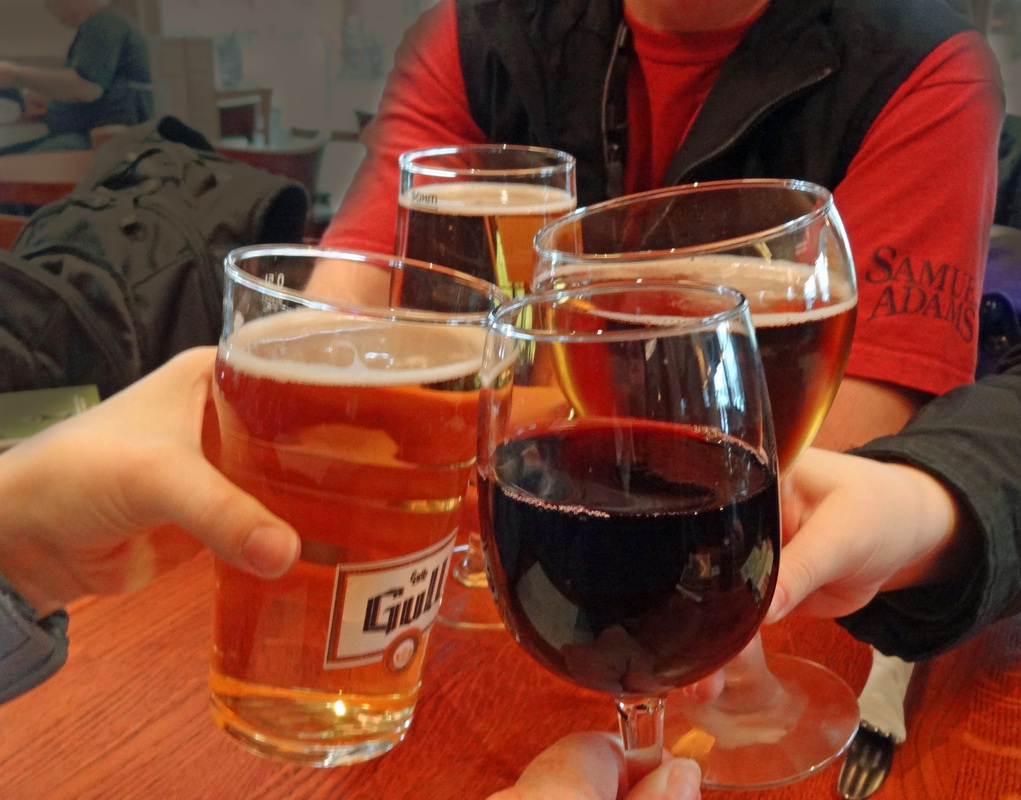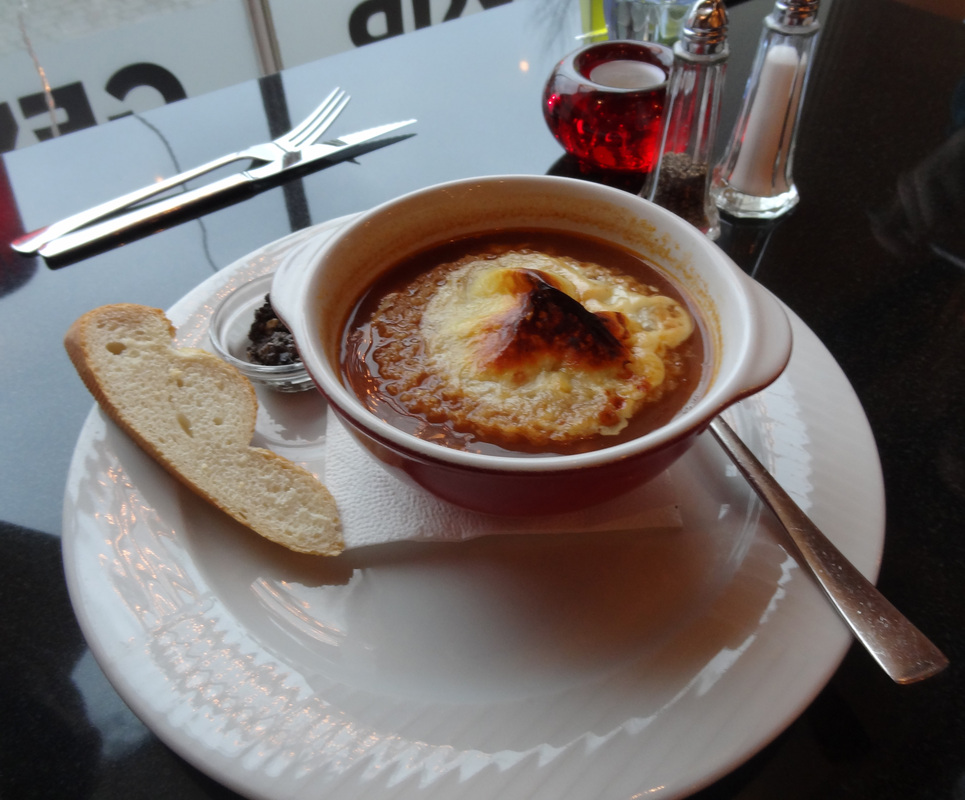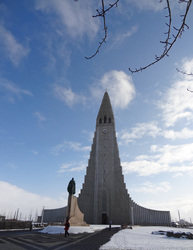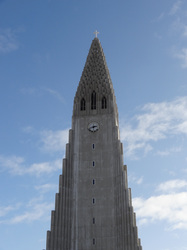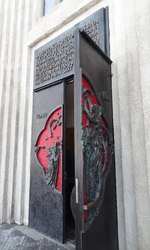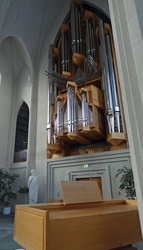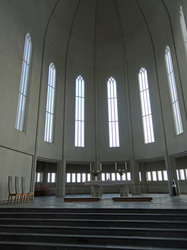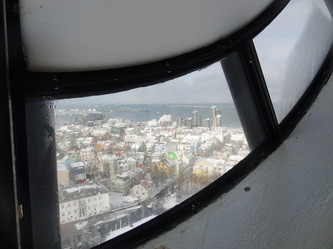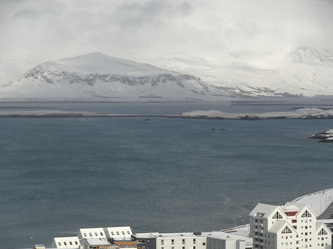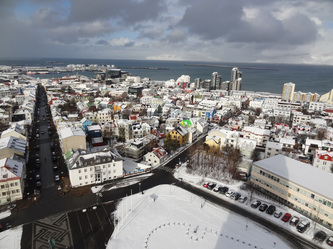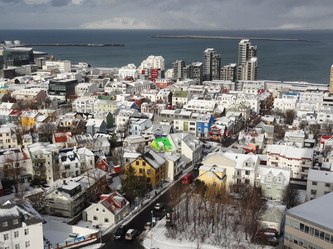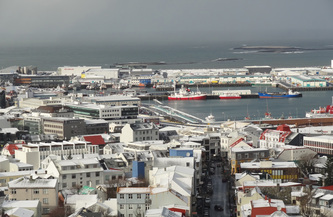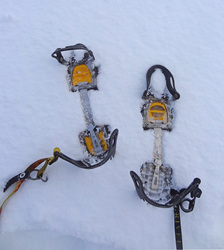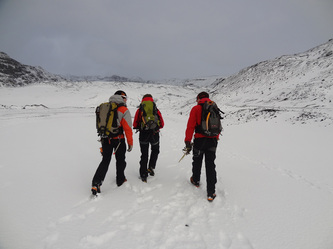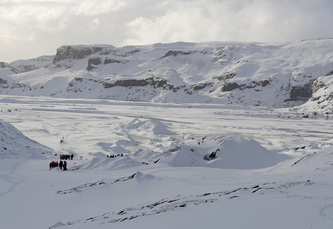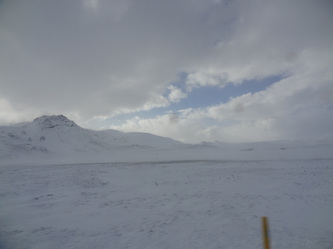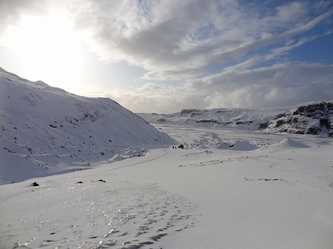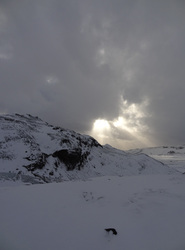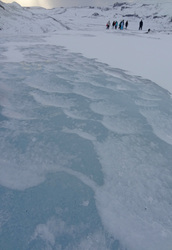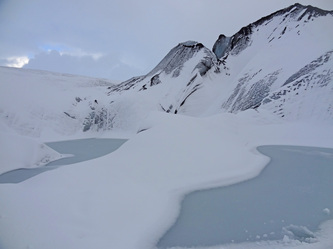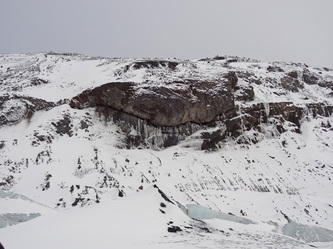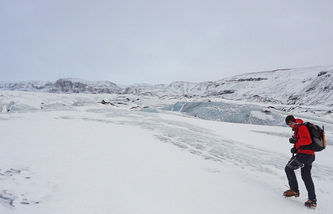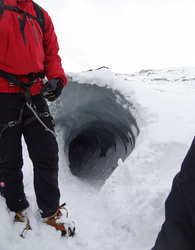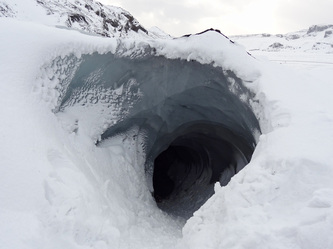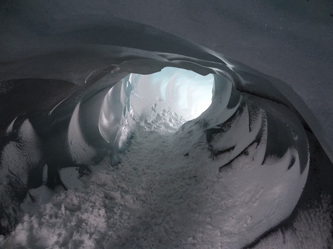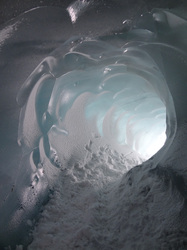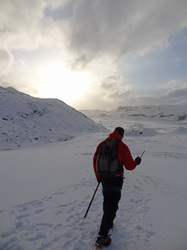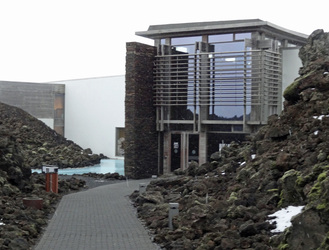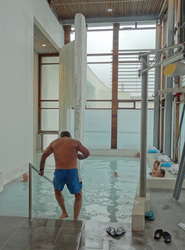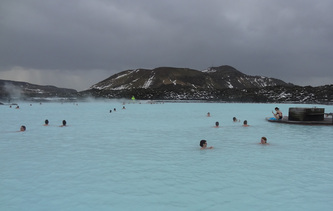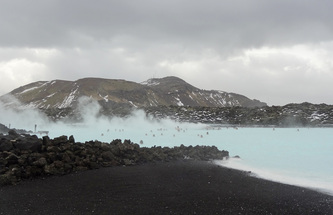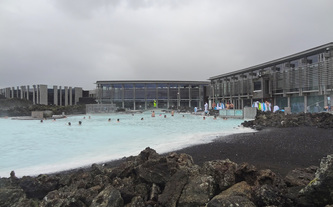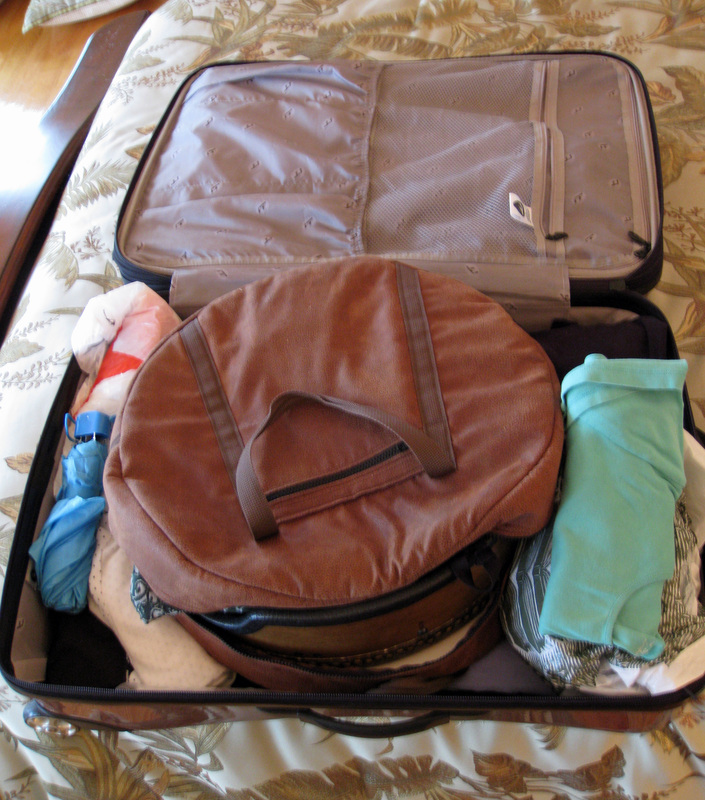|
You’re in Dublin on holidays. You’ve played at the Cobblestone and O’Donoghue's. You’ve delighted in the fine selection of musical accoutrement at Walton’s Music on Georges’ Street and rummaged through the amazing selection of trad CDs at Claddagh Records in Temple Bar. But now you have some free time, and the session at Peadar Kearney's doesn’t start until 5 (which means sometime 5:30ish, Irish Time). What’s a holidaying Irish Trad Player to do? Consider taking a short walk to an historic Dublin Trad Music shop, newly restored and re-opened. Just a 14 minute walk from Oliver St. John Gogarty’s in Temple Bar, straight up Capel Street north of the Liffey, you will find The Horse Shoe. Originally from rural Co. Clare, John Kelly was a highly respected fiddle and concertina player. He moved to Dublin and in 1945, John and his wife, Frances, opened a small music shop at 85 Capel Street. The Horse Shoe quickly became a magnet for many of the eminent trad players of the day. Seamus Ennis, Willie Clancy, Dennis Murphy, Julia Clifford, Patsy Geary, Bobby Casey , Johnny Leary, and Joe Heaney are only a few of those who stopped by for a few tunes and a bit of musical chatter when they were in Dublin. It was from this rich soup of musicians and their chats (and sessions) at The Horse Shoe, and at the nearby Piper’s Club, that was born not only a band, Ceoltóirí Chualann, which included many musicians who later formed The Chieftains, but also where the seeds were planted for the creation of Comhaltas Ceoltóirí Éireann in 1951. The music flowed and the shop even had a tune named for it. The Horse Shoe (An Crú Capaill in Irish) was written by Patsy Geary and is also known as Patsy Geary’s Jig. John Kelly died, and the shop closed in the late 1980s. The shop, like the area in which it is located, decayed. During the Celtic Tiger, the northside neighborhood became an immigrant district and 85 Capel Street became a Romanian Market. Fast forward to 2012. Enter a self taught artist, and an amazing fiddler named Brendan P. Lynch. Brendan purchased the shop, and on November 10, 2012 re-opened the newly restored space to the public. Brendan is indeed a remarkable man. Born in Ballyboughal, north Co. Dublin, he has two solo CDs to his name: Tunes from the Hearth (2000) and From the Heart of Fingal (2005), and he is featured on CDs by many other notable artists. Brendan P. (the P is to differentiate him from the Irish author Brendan Lynch) is also the Music Director at the Arlington Hotel in Temple Bar so if you have seen the Irish Cabaret there, you have probably seen him perform. But that’s not the end of the story. The restored Horse Shoe is also used as gallery space to showcase Brendan’s beautiful line drawings, photographs and watercolours. The rooms (on 3 floors) are small, but the art and music they contain are mighty. And there you will also meet Brendan. The shop doesn’t open until 11. Brendan is a musician, after all – mornings are for yoga instructors and people with small children. And it closes at 5 - Brendan is playing out most nights. But if you bring your instrument, you might be able to get a lesson on fiddle, banjo, mandolin or bodhrán. Or look at his selection of lovingly restored fiddles. You might find yourself bringing home an extra special souvenir of your time in Dublin. I did. And now I wish I was as good as my fiddle. But even if you’re not musically talented, come and soak in the history of the place. A man with an easy laugh, Brendan will regale you with stories of the small history of Irish music. In a fitting bookend to the shop's personal music history, one of his first acts upon re-opening The Horse Shoe was to invite John Kelly’s family to a session in the shop. So that’s the story. A piece of history preserved. A new chapter begun. Best of luck to Brendan, and I thank him for his part in passing the music on. And if you're in Dublin, say hi to Brendan for me! The Horse Shoe 85 Capel Street Dublin, 1 Open 11 – 5pm most days I'll leave you here with a segment from RTÉ in June 1977. John Kelly, Sr, John Kelly Jr, and James Kelly (from the group Planxty) play Ceathrú Cavan/The Wild Irishman. UPDATE: Sadly, The Horseshoe closed it's doors in June of 2014. A shame, really.
3 Comments
 If you're of a certain age, you will remember promises being made long ago of how simple our lives would be made by the advent of the Digital Age. Society, we were told, would become paperless, and we would enter a Brave New World of information retrieval and convenience. And so it came to pass. Mobile phones are now smart. Music is instantly available and extremely portable. Computers and tablets and notebooks and iPads keep us constantly in the loop and all the information known to mankind is stored in the Cloud, ready to be retrieved at our whim by Google search. Why, then, was I so afraid when I was cleaning out the closet and came across a large, closed box? Well, it wasn't exactly closed. It was too full for the lid to fit tightly and its overflowed content threatened to twine around my arms like an Evil Constricting Vine as envisioned by a Hollywood special effects master. Then - disaster! I dropped the box and the malevolent mass was free on the floor. I was looking at every piece of wire that ever came into the house with a new electronic gadget. We all have nests of these orphaned snakes of plastic coated copper in the house somewhere. At least I hope we do. I'd hate to think I was the only one who is afraid to throw away a perfectly good piece of technology, especially when it comes wrapped with a twist tie and so nicely packaged in a little zip-lock baggie. And what about all those poor under paid Chinese children who toil night and day to produce these cables and connectors and power cords? How can I not value their efforts? But what do you DO with these things? Every time you purchase a new device, it comes with more cables than you need, because the cables from the old machine you are replacing still work just fine, thank you very much. I learned a while ago to keep the ones I use frequently slung over the door to the computer cabinet. That way when I want to upload photos from my camera (mini USB to USB in computer) or sync my iPod (stupid Apple has to use proprietary plugs different from everyone else in the world), I don't have to dig through the smaller stash of rechargers and connectors I keep in a drawer. But these things spawn in the dark. And like some new archeological find, their purpose is lost in the mists of time. There's a plug on one end. Fine. That one is easy. It goes in the wall socket. The other end presents more of a challenge. It's round but it doesn't appear to fit into the hole of any electronic gadget I currently own. And the square transformer box on the wire is no help. All it says is "Class 2 power supply. WARNING ..." and then goes into a bunch of electrical jargon that I feel stupid for not understanding. I can't throw these things away. Perhaps I'm a secret hoarder. I cried out for help once. I took the entire box to a computer repair man and told him to take anything he would find useful. He looked at me with pity and revulsion, and said that they hadn't manufactured the Commodore 64 since 1988, and it was probably safe to get rid of that one. The Digital Age has, to an extent, gone paperless. Instead we are left with a plate of electronic spaghetti which I think is harder to get rid of. But this time I'm not going to put the box back in the closet. Oh, no. I think I'll have my husband carry it to the basement instead. 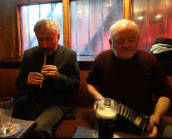 How often have you gone to a concert or session to have the performer say something along the lines of "I got this tune off the legendary Joe Pat O'Shaunessy one night we were locked in at the aulde Harp and Pint Pub in Bailebeag, Co. Donegal. He was a fine fiddler so, and now his grandson is grown and teaching this same tune to his own children." Do you feel inferior yet? How many of the tunes you know did you learn at the knee of some Jedi Master of Irish music? This is the dilemma that we, as musicians who play Irish music but whose parents had the misfortune not to birth us somewhere in rural Co Kerry face daily. Ah, the shame! We have rhythm but our parents didn't. What is a poor American (Irish) musician to do? We work with what we have. We turn to technology. It starts innocently enough. You buy a CD or download an mp3 file of a couple of tunes that strike your fancy. I'm going to learn that set, you think. But wait, the tune rushes past your ears faster than the beer you just drank requires recycling. Was that da da da DA da DAAA ~or~ da da DAAA da da DAAA?, you ask yourself. Well, there's software for that. Some people swear by the Amazing Slow Downer, but for ease of use and added features I personally prefer Transcribe! Despite the name, Transcribe! does NOT actually transcribe the music into notation. (There is a software that does that - TwelveKeys - but I've never used it so I can't speak to it's functionality.) With Transcribe!, you can slow down any music file on your computer or change the key it's played in without hurting pitch in the least. The tunes work best. If you try the program on a song you get an amusing reverse homage to the Chipmunks. Oh, no, no!, you say. I learn MY tune sets the old fashioned way -- by going to sessions. All I can say is you must have a phonographic memory. Or a really good digital recorder. Some people have good luck using their iPhone recording app, but I think I must be dumber than my smart phone. The choice of digital recorder is as personal as your comfort level with the number of buttons you have to push to get it to work. Personally, the less I have to manipulate small switches or touch screens in a darkened pub after having a beer or two the better. I own the Zoom h4n. I find it a bit difficult to operate quickly, but if you are less technologically impaired than me and do manage to get it running in a timely fashion, the sound fidelity is great and it's easy to upload the files to your computer. The only other downside is that the unit itself is very bulky. It's really hard to be inconspicuous as you set it up and get it started. I recently purchased the Olympus LS-5, which is much smaller than the Zoom, and promises to be much easier to use. (Strangely enough, I found this unit for more than half the price of Amazon.com at an online record shop in the UK, even after the shipping. Go figure!) The Olympus model has a lot fewer buttons to push - so far so good. I'm not saying that I've got the best recorder going, I'm sure there are very good ones out there that I don't kow about. If you'd like to check out a nice comparison review of other models, click here. There's An App for That: You're at your Thursday night session. The group swings into a tune you KNOW you know. But you can't for the life of you remember what the name of it is. It's driving you MAD. Well, there's an app for that too. It's called Tune Pal. It's a digital version of the old TV show "Name That Tune". All it needs is a few bars of the tune to identify what's playing. In fact it's so accurate that there are people who try to play very obscure tunes just to see if they can stump the Tune Pal. And not only will it identify the tune, it will give you the ABC notation as well. It's available for iPhone, iPad, Android and you can use it on your PC if you have a microphone hooked up. And just last month a new app came out, created by an Irish woman, and performed by a 15 year old girl from Cork called "Irish Fiddler". There are also apps for tuning your instrument, Metronome apps, Guitar Tab apps and so very much more.
Things change. You can't smoke in the pubs anymore. The Celtic Tiger is now a scarred old tabby cat. And in Ireland, pubs are closing at the rate of one every two days. Pretty soon that dark, sticky old pub won't even be there to house the current Fiddle Hero. Traditional music isn't really learned in the traditional fashion any longer, even in Ireland. We are the test tube babies of Irish music. It doesn't make us any less legitimate so long as re respect the music. Welcome to the digital age. PS - I'd love to hear what devices you use to help in your study of the music. If there are enough responses, I'll update the blog to include them. According to the Icelandic government website, on January 1, 2012 the population of Iceland was 319,575. That’s about the population of St. Louis, Missouri, spread over an area equivalent to the state of Kentucky. In other words, it’s small. And all I really knew about Iceland before I traveled there was: 1. They had a volcano that had erupted in 2010, the ash from which closed airports around Europe, and nearly cancelled a trip I had planned to the UK, and 2. During the 2008 World Banking Crisis, the Icelandic government had, unlike Ireland and other EU countries, let their banks fail rather than saddle their taxpayers with crippling debt. Well, it’s 2012, and while no one can say the Icelandic economy is back to the boom years, Iceland is definitely open for business. We arrived at Keflavik International Airport in the pre-dawn hours of the morning and discovered the first thing about being a tourist in Iceland. Things are expensive. The airport is about a 45 minute drive from Reykjavik, and you have 3 choices: rent a car, take the Flybus, or hop in a taxi. The rental was a non-starter as our tour plans did not require a car. The Fly Bus was going to cost the 4 of us 10,000 Icelandic Krona (about $80 USD) for a trip to the Reykjavik Central Bus terminal, where passengers are off loaded to smaller buses which take them to their hotels. Somehow having to wait in various lines, and load and unload our luggage multiple times did not appeal after a sleepless overnight flight. So we opted for the taxi., which cost us $120 USD to the door of the Hilton Nordica. In the taxi we learned our second and third Icelandic lessons: everyone in Iceland speaks passable English (though I wouldn’t want try to discuss Proust's use of religious imagery, or nuclear physics), and no one lets the weather slow them down. The sky was still black as we settled in the back of the taxi. Fat, white snowflakes filled the path of the taxi’s headlights, obscuring everything but the blurry, red glare of the tail lights of the vehicles we followed. Still the cabbie raced down the highway, slipping here and there as his tires lost traction over patches of ice. In reckless style that would do a Manhattan cabbie proud, our driver defended his lane from invading trucks and passed out the less stouthearted. Pretending nonchalance, my husband quietly pull his seat belt on, and the rest of us quickly followed suit. Fortunately, we did not become Iceland's latest road fatalities, and after a nice shower and even nicer nap, felt ready to take on the capital city of Iceland. Reykjavik is home to 60 percent of Iceland’s population, and is the world’s northern most capital city, but it’s still a small town. Think Portsmouth, New Hampshire or Newport, Rhode Island. There aren’t a lot of flashy or gimmicky tourist attractions to visit, although there are definitely the usual number of souvenir shops. The beautiful fleece lined Icelandic knit hat I bought was 33,000 Icelandic Krona. I nearly put it back on the shelf, until my husband reminded me that one Krona is worth approximately .08 US cents. And there’s no tipping in Iceland. A friend (thanks, Mike!) had told us this before we left Boston, but coming from the land of the Free and the Home of the 20% gratuity, we still felt uncomfortable about leaving a table littered with dirty dishes but no coinage. So I flagged down our waitress at the Café Paris, and asked her if indeed we shouldn’t leave her a little something extra. She was flustered by the question, but when I assured her that I wasn’t trying to be fresh, I just wanted to do the right thing, she relented and admitted that tipping was not expected and that the restaurant paid the waitstaff a living wage. My husband did notice that there was a tip glass near the bartender, but the few lonely bank notes in it were American currency – no Krona. It seems we weren’t the only tourists who weren’t sure of local custom – we were just the ones who thought to ask. One of our two favourite tourist sites in Reykjavik was Hallgrímskirkju, the largest church in Iceland (Lutheran). The architecture was unusual, and the views from the Bell Tower were superb. I found it interesting that the interior space, unlike a European church of similar age, was simple and unadorned. But the clean lines reflect light beautifully, and in a country where there are months at a time with scant daylight, that seems like a very clever design choice. (Click on photos to enlarge) The other of our favourites was the National Museum. Well laid out and well labeled (in English!), it provided a history of Iceland through commentary and artifact that really helped World History ignorant North Americans understand how Iceland came to be what it is. There’s one other museum I feel I must mention. My husband found a pamphlet for it, but sadly my daughters and I just never could find the time in the schedule to accompany him there. It was called The Icelandic Phallological Museum, and it is home to more than 215 male phalluses, from mouse to whale, including a number of homo sapiens specimens. The curator is described as “a child of Nature, a hunter/fisher and a self-taught master chef. As a second generation phallologist he is expected to set the standard for phallology worldwide.” I wish we could have found the time to stop by and ask the Curator how the specimens were harvested, but alas, we may never know. Perhaps it's better that way. Our other two most favourite things to see are easy to choose: The Blue Lagoon and Sólheimajökull. I won’t even attempt to tell you how to pronounce Sólheimajökull. I never learned how, even though I tried, and am fairly good at wrapping my tongue around other languages. But Sólheimajökull is a glacier about 2 hours drive from Reykjavik, and it is well worth the drive. We took a tour with MountainGuides.is. They showed us how to strap the crampons to our boots, handed us ice axes, and took us for a long glacier hike. The scenery was amazing, and when the sun broke through the clouds, the sky looked like a Renaissance painting of glories from heaven. A soul soothing activity! If you have a late afternoon or evening flight, the Blue Lagoon is a perfect way to end your Icelandic holiday. The tour bus collects you and your luggage from your Reykjavik hotel about 9am. The tour company has a small, secure area at the Blue Lagoon to store your luggage while you soak yourself in Iceland’s largest thermal pool. It’s the one time in my life I was happy to be up to my ears in hot water, especially once I discovered the swim-up bar. Live Blue Lagoon Webcam (remember they're 5 time zones ahead) It’s pretty sweet to be holding a cocktail and letting the falling snow melt on the top of your head while the rest of you is toasty warm in the mineral water. Just beware of people whose faces are slathered in algae and mineral mud sneaking up on you. Spa gurus say it’s therapeutic and cures many skin ailments. I say it dried out my skin and made me look damn silly in the process. Mid afternoon, once you are showered and wrapped snugly back in your warm parka, you are transported to Keflavik Airport to start your homeward journey.
So what have I learned about Iceland since I visited? Well, it’s still small. I hope the banks don’t fail again, and in all probability the volcano will erupt once more. But, for symmetry’s sake, two points: 1. I think I would spend less time in Reykjavik, and a lot more time in the country side. Iceland is all about breathtakingly beautiful scenery and glaciers and geothermal pools and volcanoes and riding the short shaggy Icelandic horses. There are farm stays and kayaking adventures, and the food is very tasty, even for someone who prefers to eat meat, not fish. 2. Just because a place is small, and possibly less glamorous than other parts of the world doesn’t mean it doesn’t have something new to show us. We only need to slow down and enjoy the experience. For me, going to the Guinness Storehouse tour in Dublin is something of a let-down. I find it unengaging and disjointed. Admittedly, I'm in the minority here. Trip Advisor reviewers rated it the 24th best of 218 attractions in Dublin. I've been 4 times (don't ask) and I keep trying to like it, but I just can't warm to it, unlike the tour at Kilmainham Jail, which ranked 4th on the Trip Advisor list. And it's pricey. Buy the tickets online at the Guinness website for a small discount (better than nothing) and to avoid the hordes of tourists in line waiting to buy tickets. Don't worry, though, you'll meet them all again later inside. The best part of the whole experience, with the possible exception of the Gravity Bar and its free pint, (if you can find a place to sit to drink it) is the small room tucked off to the side on one of the upper floors dedicated to Guinness advertisments. I LOVE the vintage Guinness ads. I love their textual simplicity and repetition of characters like the Zookeeper and lobsters and the TOUCAN. I love the toucan. But how did Guinness come to chose a tropical bird with a big beak to be the mascot of a stout beer? The short answer is no one knows for sure. But there are some broad clues. The Guinness Toucan first appeared in 1935, and was the brainchild of artist John Gilroy, who worked for a London advertising agency. Said Gilroy in the London Times: "The Guinness family did not want an advertising campaign that equated with beer. They thought it would be vulgar. They also wanted to stress the brew's strength and goodness. Somehow it led to animals." For over 45 year the Toucan was an iconic symbol of Guinness. Around 1982, Guinness decided to retire the Toucan, and go in other directions. Personally, I miss him. Although as we've moved into the digital age, some Guinness advertising is still quite amusing: "Why", my husband asks me -- not for the first time -- "Didn't you take up the whistle?" He's surveying the quantity of goods scattered around our bedroom that I hope to cram into the waiting suitcase for my trip this evening to Dublin. I'm going to the Temple Bar TradFest, and no, it's not too many clothes that are evoking his dismay. Trad musicians don't tend to be fashion plates. The main object of his concern is my gorgeous, built like a tank, 18" Mance Grady bodhrán. When I first purchased it from Mance, he respectfully suggested that a woman of my size -- a mere 5'2" -- might be better off with a smaller diameter drum. But nothing would do for me but the deep booming tones of the 18". However Aer Lingus, in its airline wisdom, will not allow my baby to be brought as carry on luggage and forces me to check my lovely drum with the dirty laundry and toothpaste that inhabit the depths of the cargo hold. I'm not typically a nervous flier, but exposing my prize possession to the tender mercies of the baggage handlers causes hives to form on my neck and I tend to drink too much on the flights on which my bodhrán accompanies me. This isn't the first time my bodhrán has crossed the Atlantic. The last three years, it has come with me each May to the World Bodhrán Championships in Miltown, Co. Kerry. I wish it were eligible for Frequent Flier miles -- then eventually it would have a ticket for a seat right beside me, and I wouldn't have to drink that third bottle of red wine. But I have worked out a system. Loosen the lugs as easy as they can go. The skin flops like Ethel Merman's upper arms. Cut two pieces of thick foam core to the drum's diameter. One goes on the drum head, the other on the inside of the drum by the skin. Put the drum back in it's case. Stuff all my socks and soft T-shirts and ladies' unmentionables inside the drum to pad it out to the edge of the rim and roll all my jeans and sweaters around it to try to cushion the inevitable game of Kick the Can that baggage handlers appear to delight in. So far, so good. Each time it has arrived safely and tuned up beautifully, and I had a great time playing it in classes, workshops and pubs.
But this trip, the plane leaves in an hour and a half. (Thank you, Logan Airport, for the free wi-fi.) I've already check my suitcase (drum inside) and entrusted its welfare to Aer Lingus. My heart is racing and my palms are starting to sweat. Please please PLEASE be good to my baby. I've ordered a 16" bodhrán from Mance. He's working on it even as we speak. That should satisfy the carry on requirements. And bring down my blood pressure ... ===================================================================== ===================================================================== Originally printed in February 2010, but the website it was on crashed and burned and is gone now. Yes, my 16 inch drum is gorgeous (thank you, Mance) AND it fits in the overhead compartment. A few years ago, some very good friends of mine told me that over the Christmas holidays they had gone to see a production of "Cinderella" in Dublin. I admit with some embarrassment now that I razzed them unmercifully. What on earth would two grown adults find to attract them to a children's show? Eventually there was no more fun to be had in teasing them, and the matter was dropped. Then by chance, I happened upon an online article about the British phenomenon of the Panto. Once again it was proved to me that even though we share a language, we don't always mean the same thing when we speak it. The Panto is a holiday tradition that dates back to the 15th and 16th century traditions of Commedia del Arte. There are stock characters, which include the Pantomime Dame (always played by a man), the Principle Boy (played by a young woman), and the Comic Animal (we had a mermaid). It takes a children's story or folk tale, and adds enough adult innuendo so Mum and Dad can chuckle indulgently while the off colour humor sails safely over the heads of the children. The costumes are colourful, the sets elaborate and the special effects plentiful. Audience participation is key, and very much encouraged by the performers, who consistently break the theatrical "Fourth Wall" to speak directly to the crowd. The villain is booed and hissed when he enters, the hero is warned ("He's behind you!") and when someone makes a declarative statement, the audience will respond ("Oh, yes it is!" or "Oh, no it isn't!"). It's a good thing the rotten tomato stall next door to the theatre was closed. I happened by the Gaiety Theatre in Dublin a few days before their Christmas Panto closed this year. As you might expect at the end of a 3 month run, there were tickets to be had, and I invited my Dublin friends to accompany me that evening to "Robinson Crusoe and the Caribbean Pirates". With the coaching of my friends, I hissed the villain and warned the hero with the rest of crowd . I haven't had so much fun at the theatre in quite a while! I'm really hoping I'll be in Dublin before next year's holiday Panto closes. I'm hooked. :) |
Archives
March 2013
Search Words
All
|
